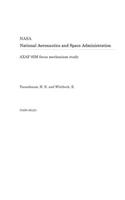
Axaf Sim Focus Mechanism Study
Series:
The design requirements and initial design concept for the AXAF-I Science Instrument Module (SIM) were reviewed at Ball on September 29, 1993. The concept design SIM focus mechanism utilizes a planetary gearset, with redundant motors, to drive a large ring (called 'main housing bearing') via a spur gearset. This large drive ring actuates three tangent bar links (called 'push rods'), which in turn
NaN
VOLUME
English
Paperback

The design requirements and initial design concept for the AXAF-I Science Instrument Module (SIM) were reviewed at Ball on September 29, 1993. The concept design SIM focus mechanism utilizes a planetary gearset, with redundant motors, to drive a large ring (called 'main housing bearing') via a spur gearset. This large drive ring actuates three tangent bar links (called 'push rods'), which in turn actuate three levers (called 'pin levers'). Each of the three pin levers rotates an 'eccentric pin, ' which in turn moves the base of a bipod flexure in both the radial (normal to optical axis) and axial (focus along optical axis) directions. Three bipod flexures are employed, equally spaced at 120 degrees apart, the base of each being translated in the two directions as described above. A focus adjustment is made by rotating the drive ring, which drives the push rods and therefore the pin levers, which in turn rotate the eccentric pins, finally imparting the two motions to the base of each of the bipod flexures. The axial translation (focus adjustment) of the focused structure is the sum of the direct axial motion plus axial motion which comes from uniformly squeezing the three bipod bases radially inward. SAO documented the following concerns regarding the focus mechanism in memo WAP-FY94-001, dated October 7, 1993: (1) The focus adjustment depends, in large part, on the structural properties (stiffnesses and end fixities) of the bipod flexures, push rods, pin levers and eccentric pins. If these properties are not matched very well, then lateral translations as well as unwanted rotations of the focussed structure will accompany focus motion. In addition, the stackup of linkage tolerances and any nonuniform wear in the linkages will result in the same unwanted motions. Thermal gradients will also affect these motions. At the review Ball did not present supporting analyses to support their choice of this design concept. (2) The proposed 'primary' method of measuring focus i
Price Comparison [India]
In This Series
Bestseller Manga
Trending NEWS




















